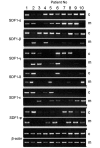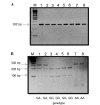Analysis of the expression of SDF-1 splicing variants in human colorectal cancer and normal mucosa tissues
- PMID: 26998092
- PMCID: PMC4774538
- DOI: 10.3892/ol.2016.4139
Analysis of the expression of SDF-1 splicing variants in human colorectal cancer and normal mucosa tissues
Abstract
C-X-C motif chemokine ligand 12 (CXCL12), also termed stromal cell-derived factor-1 (SDF-1) is a small protein 8-14 kDa in length that is expressed as six isoforms, consisting of SDF-1α, SDF-1β, SDF-1γ, SDF-1δ, SDF-1ε and SDF-1θ. All six isoforms are encoded by the single CXCL12 gene on chromosome 10. This gene regulates leukocyte trafficking and is variably expressed in a number of normal and cancer tissues. The potential role of the novel CXCL12 splice variants as components of the CXCR4 axis in cancer development is not fully understood. The present study aimed to analyze the expression profile of the various SDF-1 isoforms and SDF-1 polymorphisms, and the association with the clinicopathological features and overall survival of patients with colorectal cancer (CRC). SDF-1 polymorphism analysis was performed using restriction fragment length polymorphism (RFLP) analysis in 73 histologically confirmed human CRC tissue samples at various stages of disease. The expression pattern of the SDF-1 isoforms was analyzed by reverse transcription-polymerase chain reaction in 40 histologically confirmed human CRC tissue samples obtained at various stages of disease, as well as in matched adjacent normal mucosa samples. The presence of the CXCL12 gene polymorphism rs1801157 demonstrated an association with local progression of the primary tumor, as indicated by the T stage. The frequency of the GG genotype was slightly increased in patients with stage 3 and 4 tumors (78.0%) compared with the incidence of the GA/AA genotype (69.5%; P=0.067). The expression of SDF-1β was associated with the presence of metastases (P=0.0656) and the expression of SDF-1γ was significantly associated with tumor size (P=0.0423). The present study is the first to analyze the association between the expression profile of the chemokine CXCL12 splice variants in human CRC tissues and their clinical relevance. The present results reveal that the CXCL12 G801A polymorphism is a low-penetrance risk factor for the development of CRC, and was associated with the T stage. All six isoforms of SDF-1 were expressed in CRC tissues. The expression of SDF-1β was found to be associated with metastases and SDF-1γ appears to be a possible tumor marker for local tumor progression.
Keywords: C-X-C motif chemokine ligand 12; colorectal cancer; isoforms; stromal cell derived factor 1 splice variants.
Figures


References
-
- Weir HK, Thun MJ, Hankey BF, Ries LA, Howe HL, Wingo PA, Jemal A, Ward E, Anderson RN, Edwards BK. Annual report to the nation on the status of cancer, 1975–2000, featuring the uses of surveillance data for cancer prevention and control. J Natl Cancer Inst. 2003;95:1276–1299. doi: 10.1093/jnci/djg040. - DOI - PubMed
LinkOut - more resources
Full Text Sources
Other Literature Sources
